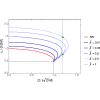当前位置:
X-MOL 学术
›
Phys. Rev. D
›
论文详情
Our official English website, www.x-mol.net, welcomes your
feedback! (Note: you will need to create a separate account there.)
Charged black holes in Einsteinian cubic gravity and nonuniqueness
Physical Review D ( IF 4.6 ) Pub Date : 2020-07-10 , DOI: 10.1103/physrevd.102.024035 Antonia M. Frassino , Jorge V. Rocha
Physical Review D ( IF 4.6 ) Pub Date : 2020-07-10 , DOI: 10.1103/physrevd.102.024035 Antonia M. Frassino , Jorge V. Rocha

|
Black holes are the simplest objects in the universe. They correspond to extreme deformations of spacetime geometry, and can exist even devoid of matter. In general relativity, (electro)vacuum black holes are uniquely determined by their mass, charge and angular momentum. This feature follows from a uniqueness theorem, which can be evaded if one considers higher dimensions or matter fields coupled to gravity. Here we find that Einsteinian cubic gravity, a well-motivated modification of Einstein gravity that includes third-order curvature corrections in accordance with low-energy effective theory expectations, admits black hole solutions with charge greater than mass, when minimally coupled to a Maxwell field. Moreover, we find that, in this regime, there can be two asymptotically flat black holes with the same charge and mass, posing the first example of vacuum black hole nonuniqueness in four dimensions that is free from pathologies. Examination of these black hole's thermodynamics reveals that when two branches coexist only the larger black hole is thermodynamically stable, while the smaller branch has negative specific heat. Einsteinian cubic gravity unveils two further surprising features. The charged black holes do not possess an inner horizon, in contrast with the usual Reissner-Nordstr\"om spacetime, thus avoiding the need to resort to strong cosmic censorship to uphold determinism. In addition to black holes, there exists a one-parameter family of naked singularity spacetimes sharing the same mass and charge as the former, but not continuously connected with them. These naked singularities exist in the under-extremal regime, being present even in pure (uncharged) Einsteinian cubic gravity.
中文翻译:

爱因斯坦三次引力和非唯一性中的带电黑洞
黑洞是宇宙中最简单的物体。它们对应于时空几何的极端变形,甚至可以在没有物质的情况下存在。在广义相对论中,(电)真空黑洞由它们的质量、电荷和角动量唯一决定。这一特征遵循唯一性定理,如果考虑更高维度或与重力耦合的物质场,则可以避免该定理。在这里,我们发现爱因斯坦三次引力是爱因斯坦引力的一种动机良好的修改,包括符合低能量有效理论预期的三阶曲率校正,当与麦克斯韦场最小耦合时,承认电荷大于质量的黑洞解. 此外,我们发现,在这种情况下,可以有两个具有相同电荷和质量的渐近扁平黑洞,提出了第一个没有病理学的真空黑洞在四个维度上的非唯一性的例子。对这些黑洞的热力学的检查表明,当两个分支共存时,只有较大的黑洞在热力学上是稳定的,而较小的分支具有负的比热。爱因斯坦的三次引力揭示了另外两个令人惊讶的特征。与通常的 Reissner-Nordstr\"om 时空相比,带电黑洞不具有内部视界,因此无需诉诸强大的宇宙审查来维护确定性。除了黑洞之外,还存在一个单一参数裸奇点时空家族与前者共享相同的质量和电荷,但不连续相连。这些裸奇点存在于极值状态下,
更新日期:2020-07-10
中文翻译:

爱因斯坦三次引力和非唯一性中的带电黑洞
黑洞是宇宙中最简单的物体。它们对应于时空几何的极端变形,甚至可以在没有物质的情况下存在。在广义相对论中,(电)真空黑洞由它们的质量、电荷和角动量唯一决定。这一特征遵循唯一性定理,如果考虑更高维度或与重力耦合的物质场,则可以避免该定理。在这里,我们发现爱因斯坦三次引力是爱因斯坦引力的一种动机良好的修改,包括符合低能量有效理论预期的三阶曲率校正,当与麦克斯韦场最小耦合时,承认电荷大于质量的黑洞解. 此外,我们发现,在这种情况下,可以有两个具有相同电荷和质量的渐近扁平黑洞,提出了第一个没有病理学的真空黑洞在四个维度上的非唯一性的例子。对这些黑洞的热力学的检查表明,当两个分支共存时,只有较大的黑洞在热力学上是稳定的,而较小的分支具有负的比热。爱因斯坦的三次引力揭示了另外两个令人惊讶的特征。与通常的 Reissner-Nordstr\"om 时空相比,带电黑洞不具有内部视界,因此无需诉诸强大的宇宙审查来维护确定性。除了黑洞之外,还存在一个单一参数裸奇点时空家族与前者共享相同的质量和电荷,但不连续相连。这些裸奇点存在于极值状态下,











































 京公网安备 11010802027423号
京公网安备 11010802027423号